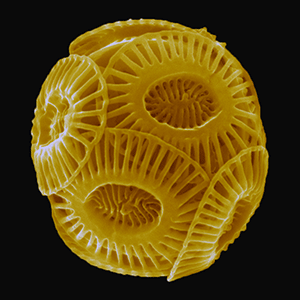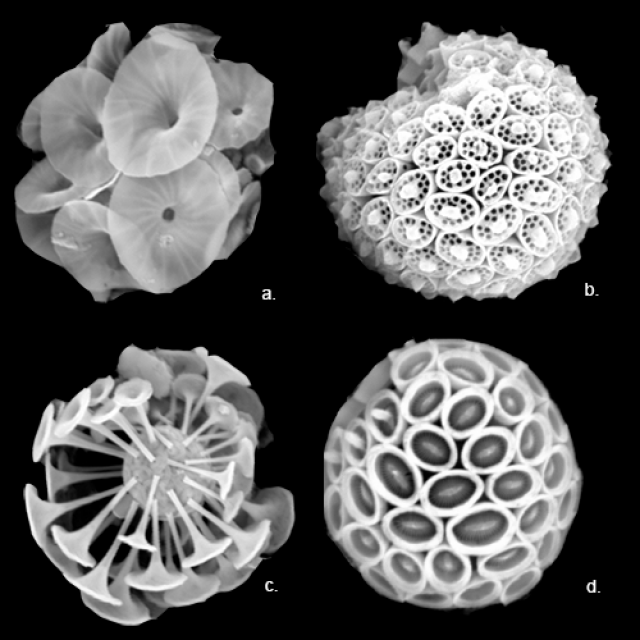
The Magical World of Coccolithophores
Teachers down load the word document at the end of the article with questions.
 |
|
These photographs show 4 coccolithophores found in water samples taken in the Pacific on 25th November 2016 from a depth of 5 m. The images were taken on a Scanning Electron |
They produce a significant amount of the world’s oxygen and yet many of us have never heard of them. These coccolithophores are tiny photosynthesizing algae that live in the sea. There are billions in seawater with a diverse range of species all with their own astonishingly beautiful intricate shells. They have an outer layer made up of intricate calcium carbonate plates called coccoliths arranged in a sphere that contains a single cell. Like all algae this cell uses light energy from the sun to make food.
The life cycle for these organisms is unlike that of conventional plants. In a regular plants most plant cells have two sets of chromosomes. These cells are diploid (2N). These carry the genetic material required by the plant. However some of the cells, those involved in the plants reproduction, are haploid (1N). These cells only contain one set of chromosomes. In flowering plants these cells are the pollen and the ova. The pollen and ova cannot grow independently but must fuse together to make a diploid (2N) seed for the next generation of plants to grow. This is not the case with coccolithophores and other algae. In the case of coccolithophores both the haploid (1N) and diploid (2N) cells function fully independently AND asexually reproduce.
Asexual reproduction occurs when a parent makes an identical genetic replica of itself. Consequently there is no increase in genetic diversity. Asexual reproduction allows for the rapid increase of numbers when conditions are good. Coccolithophores can divide every day under good conditions. One parent cell divides into 2 daughter cells.
Coccolithophores can also divide from a diploid (2N) cell into a haploid (1N) cell. This is called meiosis. The new haploid (1N) cells make a different design of calcium carbonate shell to their parent. Emiliania huxleyi is the commonest coccolithophore found in today’s oceans. It is found in all the oceans in large numbers. In the case of Emiliania huxleyi the haploid (1N) has no shell at all. As water conditions change again haploid (1N) cells come together to reform diploid (2N) cells. This allows the mixing of genetic material and lead to greater genetic diversity, which is important for any species to have resilience to changing conditions.
What triggers the change from diploid to haploid?
There seem to be several factors that trigger this response. These include water temperature, nutrient levels and viral attack.
At the start of a summer coastal water is usually relatively nutrient rich. As it starts to warm growing conditions are perfect. For E. huxelyi the diploid (2N) cell numbers rapidly increases. These large numbers are referred to as a bloom. As blooms contain billions of coccolithophores they can often be seen by satellites and make a big impact on the water chemistry. The nutrients in the water decrease. It is thought that this is one of the triggers that lead the diploid (2N) cells to undergo meiosis and become haploid (1N). At the same time these nutrients decrease seawater surface temperature is often increasing so it is difficult to know if it is the increase in temperature or the decrease in nutrients that causes this. Generally the haploid(1N) form of the coccolithophore seem to thrive in water with a lower nutrient content.
Certainly it would seem to be a good survival strategy to be able to change your form to adapt to prevalent conditions.
Why do they make calcium carbonate plates?
Coccolithophores build beautiful intricate structures. There have been several ideas put forward as to why they build these structures, such as:
Protection. The plates could be protection from being eaten or from attack from viruses and bacteria. Interestingly, when E. huxelyi is under attack from a virus, it transitions from its plated diploid form to its naked haploid form.
Buoyancy regulation. Position in the water column is important to optimize nutrient availability and light. Buoyancy is regulates by the combination of the less buoyant plates and the productions of oils to help the algae float. Monterio et al. (2016) however argue that movement using flagella is considerably more energy efficient than making calcite plates.
Focus or shield from light. The calcite plates are made from a single calcite crystal and are consequently clear like glass. Light will pass through them and could be directed towards the chloroplasts in the cell. Alternatively perhaps the coccoliths act as a shield to protect the algae from too much light.
Giant virus attacks on E. huxelyi.
|
Scanning Electron Microscope image of E. Huxleyi taken by Luc Beaufort.
|
Most viruses are pretty small and they contain DNA in a protein coat that replicates in host cells. However some are much larger. E. huxleyi are susceptible to attack by the very large E. huxleyi viruses that moderate the size of blooms and frequently cause the end of a bloom. However, it is not that all the E. huxleyi is killed when the bloom ends. It has a clever trick up its sleeve. It changes from its diploid form to its haploid form. The haploid form appears to be completely unaffected by the virus hiding in plain sight. Scientists have dubbed this the “Cheshire Cat” escape strategy due to the behavior of the”Cheshire Cat” in “Alice in Wonderland” evading attack by disappearing. This is unlike the more familiar ‘arms race’ that viruses and hosts undergo with a continual refinement of attack and defense armory.
How will ocean acidification affect the coccolithophores?
As atmospheric carbon dioxide increases more carbon dioxide is dissolved into seawater making carbonic acid. This results in a lowering of the pH of seawater so it becomes less alkaline. Carbonate ions become less available as a result and it is thought this may make the process of making the shell more difficult. Another theory is that the hydrogen ions formed by calcification may not pass so readily out from the cell under lower ambient pH conditions. Satellite images of the Southern Ocean seem to indicate less calcification than in the past. Changes in the thickness of the coccoliths made have been reported. For most species studied the coccoliths appear to be reducing in size and thickness. Although for one sub species of E. huxleyi off the coast of Peru this appears not to be the case.
Will Coccolithophores sequester carbon?
The production of calcium carbonate releases carbon dioxide. The production of calcium carbonate lowers the pH of the water causing moving the equilibria to release carbon dioxide.
Ca2+ + 2HCO3– –> CaCO3 +CO2 + H2O
Certainly we can conclude that coccolithophores are responsible for the movement of large amounts of calcium carbonate around the ocean and understanding this and how it may change is important. As the coccoliths sink lower in the ocean they have a tendency to dissolve increasing the pH. Upwelling water generally contains high levels of dissolved carbon dioxide due to the decomposition of organic matter. The dissolution of the calcium carbonate at depth helps reduce the degassing of carbon dioxide as this water upwells.
Why do we have experts in coccolithophores sailing on the JOIDES Resolution?
On board we have three scientists who specialize in coccolithophores. Whilst on board their main role is to date the core quickly after it is bought up on deck. They are able to do this by taking a very small sample of the sediment and mixing it with a drop of water on a microscope slide. They then observe the slide under the microscope and identify different species. Knowing the dates when different species evolved and /or became extinct enables them to age the core. It also gives clues to the water temperature at the time, as different species prefer different habitats.
Find out more.
The changes in thickness of the coccoliths:
Beaufort, L., Probert, I., de Gadridel-Thoron, T., Bendif, E.M., Ruiz-Pino, D., Metxl, N., Goyet C., Buchet, N., Coupel, P., Grelaud, M., Rost, B., Rickaby, R.E.M. & de Vargas, C., 2011. Sensitivity of coccolithophores to carbonate chemistry and ocean acidification. Nature 476, p80The affect of the E. huxelyi virus:
Frada, M., Probert, I., Allen, M., Wilson, W., and de Vargas, C. 2008 The Cheshire Cat escape strategy of the coccolithophore Emiliana huxleyi in response to viral infection. Proceedings of the National Academy of Sciences 105 41Changing from Diploid to Haploid:
Supraha, L., Ljubesic, Z., Mihanovic, H., Henderiks, J., 2016. Coccolithophore life-cycle dynamics in a coastal Mediterranean ecosystem: seasonality and species specific patterns. Journal of Plankton Research 38(5) 1178-119Why coccolithiphires calcify:
Monteiro, F. M., Bach, L., Brownlee, C., Bown, P., Rickaby, R., Poulton, A., Tyrrell, T., Beaufort, L., Dutkiewicz, S., Gibbs, S., Gutowska, M., Lee, L., Riebesell, U., Young, J., & Ridgwell, A., 2016.Why marine phytoplankton calcify. Marine Biology Sci. Ad 2016Some more Chemistry
Carbon dioxide dissolves in water to make carbonic acid.
CO2(g)+ H2O(l) <–> H2CO3(aq)
Then two equilibria are set up.
H2CO3(aq) <–>HCO3–(aq) + H+(aq) (1)
HCO3–(aq) <–> CO32–(aq)+ H+(aq) (2)
Questions for students.
-
- Describe a coccolithophore and where are they found.
- Explain the difference between a haploid and diploid cell. Name cells that are diploid and haploid in a human.
- Would you consider coccolithophores to be producers of consumers? Why?
- Explain how the ability to survive both as a haploid and diploid form could be considered an advantage to survival.
- State an advantage of asexual reproduction.
- State the conditions required to cause a bloom.
- How is the E. huxleyi strategy to avoid attack from the E. huxleyi virus unusual?
- Describe the three possible reasons scientists think that this algae makes coccoliths. Which do you think is most likely?
- Look at the chemistry equilibria. What will happen to equilibria (2) if the carbonate ion is removed? How will this effect equilibria (1) (note the relative change in concentration of the H+ will be greater than the relative change in concentration of HCO3–).
- Describe a coccolithophore and where are they found.
